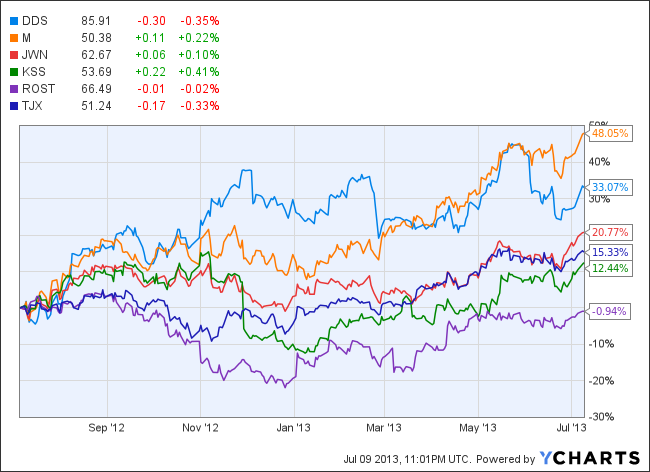Department stores have long been a go-to for one-stop shopping. Question is; can investors make money in the high-end department retailers? The higher-end market held up much better throughout the financial crisis when compared to the discounters. The higher-end department stores include Nordstrom, Inc. (NYSE:JWN), which caters to the top-end of consumers, Macy’s, Inc. (NYSE:M) and Dillard’s, Inc. (NYSE:DDS) at the low high-end.
Breaking down the high-end
Founded in 1820 and based in Cincinnati, Ohio, Macy’s, Inc. (NYSE:M) is considered the leading retailer, operating the Macy’s and Bloomingdale’s department stores across the U.S. Macy’s is focusing on inventory management and private-label offerings to help drive traffic. Differentiation is key for the department-store industry, and this includes making the sure the in-store shopping experience is excellent.

Macy’s, Inc. (NYSE:M) is also topnotch at managing cash flow; during 1Q, the company raised its dividend payment by 25% and increased its share-buyback plan by $1.5 billion — putting its total buyback plan at $2.6 billion.
Upper echelon
Nordstrom, Inc. (NYSE:JWN) has less stores than its counterparts, with only 225 stores located throughout 30 states, but retail sales are expected to be up 5.8% in fiscal 2014 — driven by 4.4% growth in same-store sales and various new-store openings.
Nordstrom, Inc. (NYSE:JWN) plans to lean on its Rack brand in the near future, where the majority of new-store openings will be Rack brand stores, with plans to double locations from the 127 in May to 230 by 2016. Notable expansion includes increasing its presence in Canada and New York.
Best investment
Dillard’s, Inc. (NYSE:DDS) is the under-followed retailer that could offer investors the best returns over the interim. Only three analysts follow the stock, compared to the 16 that follow Macy’s, Inc. (NYSE:M) and 22 for Nordstrom, Inc. (NYSE:JWN). Dillard’s has some 300 stores spread across 29 states, all under the Dillard’s brand name.
Since its 2006 decision to turn around the company, the retailer is now focused on a robust merchandise mix, where it quickly eliminates under-performing products and replaces them with promising brands. Its exclusive brands include Antonio Melani, Gianni Bini and Roundtree & Yorke — exclusive brands accounted for 21% of 2013 sales.
These initiatives helped Dillard’s post its 11th consecutive quarter of positive comps last quarter. And now its return on equity is over 17% versus 5% in 2006 and towering over the industry average of 3%. Dillard’s is also rewarding shareholders nicely, having paid out $185 million on share repurchases in 2012 and $250 million on dividends.
The other big advantage for Dillard’s, Inc. (NYSE:DDS) is the opportunity for growth in the U.S. In looking at Dillard’s store locations, it’s easy to see that even with 330 stores, the company has plenty of room for expansion in the West.

Source: mapmuse.com
Hedge fund trade
Going into the second quarter, there were a total of 39 hedge funds long Macy’s, Inc. (NYSE:M). The hedge fund with the largest position includes Lee Ainsile’s Maverick Capital, which has 3.6% of its 13F portfolio invested in the stock.
Nordstrom, Inc. (NYSE:JWN) had 24 hedgies long the stock, a 14% decrease from the previous quarter. However, its top hedge fund owner by position is billionaire Ken Griffin’s Citadel Investment Group, with a $75 million position. Meanwhile, much like the analyst coverage, hedge funds have little love for Dillard’s. The retailer had 21 hedge funds long the stock.
Don’t be fooled
Dillard’s trades at the cheapest of the high-end department stores on a price-to- earnings basis.
Dillard’s also has a top-notch balance sheet, with the lowest debt-to-equity ratio.
All-in-all, Dillard’s has solid growth prospects despite already having over 300 stores — a similar number to Macy’s, with key opportunities lying in the West. Although it can be argued that Dillard’s does not cater to the ultra high end as much as say Macy’s and Nordstrom do, this should be considered a positive, where Dillard’s can tap a larger consumer base. Macy’s, Inc. (NYSE:M) appears to be an interesting investment, with a 0.9 PEG ratio, but Nordstrom, Inc. (NYSE:JWN) appears to be too expensive with a 17.5 P/E ratio.
Marshall Hargrave has no position in any stocks mentioned. The Motley Fool owns shares of Dillard’s. Marshall is a member of The Motley Fool Blog Network — entries represent the personal opinion of the blogger and are not formally edited.
The article Investing in High-End Retail originally appeared on Fool.com and is written by Marshall Hargrave.
Copyright © 1995 – 2013 The Motley Fool, LLC. All rights reserved. The Motley Fool has a disclosure policy.







